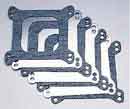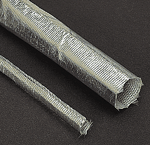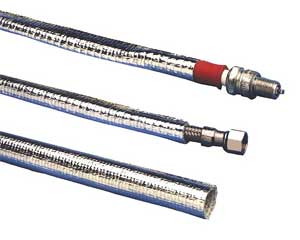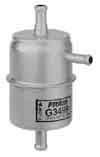If your engine has a hard time starting when it's cold...
If your engine has a hard time starting, within 10 minutes after a hot shutoff, OR...
, OR...while underway, your engine experiences vaporlock...
There can be many entry points into this conversation, so let this be the one...
Some owners advise that it's a good idea to entirely block off the exhaust passages under the intake manifold to protect the carburator from excess temperatures that will boil fuel out of the carb, after a shut off which will require a long cranking period to restart.
Note 1) An engine at correct operating temperature (175-190) will be held at that temperature by the action of the thermostat in the cooling system. This temperature is an engineering feature to assure the gasoline vaporized correctly and allowed the engine to operate smoothly.
The value of the thermostat means that it's designed not NOT allow the engine temperature go below that value
The formulation that makes up todays gasoline blend is different than it was in the old days, in that it contains ethanol (vs. MTBE) to enhance compustion and is present in almost all gasolines you purchase today. Ethanol boils at 160 degrees which creates problems for cars with carburators. Carburetors have atmospheric vents and they will allow fuel vapors to escape and reduce the fuel level in the carb. This is especially true after an engine, which has been running at operating temperature has been stopped. The underhood temps at this point well exceed 180 degrees and your carb will percolate most of if not all the fuel out into the atmosphere, leaving you with ? to start with
(Fuel injected cars have a closed system and do not have these issues with the same gasoline blends)
Another point being, while the engine is running, since the Ethanol boils at 160', and the engine operating temperature is near 180', it also increases a chance of vapor lock. This is where the fuel vaporizes in the steel fuel line, creating a bubble and since a bubble is compressable, it negates the fuel pressure from the pump. This in turn, prevents the carb bowl from maintaining capacity, so the mixture will lean out and stall the engine. (An electric fuel pump on a momentary switch (SPST) can be very instrumental in combating vapor lock while driving
Let's review the fuel system on a vintage stude
(Things to consider in counter Point:)
Point 1) Today's gasoline formulation vaporizes at much lower temperature
Point 2) Many Studes on the road show NO signs of errant fuel vapor problems
It is always important to get an engine from a cold condition to the operating temperature, as quickly as possible. This is because a cold engine doesn't have all the power available and requires more fuel and engine speed to stay running.
To get the engine to the correct operating temperature, a few items were designed into the fuel delivery system. The heat riser, the heated intake manifold, the choke stove and the automatic choke. These were all revolutionary improvements when first developed.
Heat riser
The first device to come into play is the heat riser. This is a 1/2" spacer containing an internal flap on a shaft which pivots with the help of a weighted bimetal spring. It is installed in the passenger side exhaust pipe just below the cast exhaust manifold and ahead of the exhaust pipe.
When the engine is cold, its function is very short term. The cold bimetal spring holds the flap closed and in doing so, redirects the passenger side exhaust gases, upwards, through the cylinder head, past the intake manifold chamber under the carburetor and out the drivers side of the manifold and into back the main exhaust system.
The hot exhaust will quickly heat up the exhaust manifold and unwind the heat riser spring, the action is very brief, but in the minute or two of operation, hot gasses have been redirected under the intake manifold to start the initial warmup duties. With the spring unwound, the exhaust is allowed to flow normally out the passenger side pipe, but exhaust pulses from both sides, flow back and forth under the manifold to maintain an even temperature.
Heated Manifold and Automatic Choke Stove
An intake manifold has two separate sets of passageways. The primary set being the runners for the fuel system to deliver fuel to the cylinders. The other is a chamber below the center of the manifold, which has a port on both sides of the engine accessed by the exhaust gases. The choke stove is the area on the passenger side of the intake manifold where there's a loop of steel tubing exposed to the internal flow of hot exhaust gas. The two ends of the loop are visible above the manifold on the passenger side. One end has another tube from the carburetor choke housing inserted in it. This tube is used to draw heated air into the choke thermostat housing to heat up and expand the choke spring, forcing it to pivot the choke plate to pivot vertically (open). The tube is not open to the exhaust, but merely a loop in the exhaust stream that draws heat from the exhaust. Some applications have an air filter on the open end of the loop, some have a hose to the air cleaner housing.
The intake manifold floor, under the carburator is an area which is functionally heated by exhaust gasses to vaporize fuel coming through the carb.
In the brief period that the heat riser is in operation, the exhaust gasses begin to warm up the floor of the manifold, so that minute fuel droplets encountering this heated floor, are vaporized while the mixture is on the way to the cylinders.
While the riser is closed (cold), the exhaust is forced under the manifold and exits into the drivers side of the manifold into the exhaust pipe. The heat from the exhaust is transferred to the intake manifold to speed up the fuel vaporization when the engine is cold.
The heat riser will open within two minutes of engine operation, but by that time enough heat has been transferred to the manifold floor and choke stove to improve fuel vaporization. Even after the heat riser opens, the secondary warmup system will continue at a slower pace. This is the automatic choke.
Automatic Choke
 The heat chamber, cast into the manifold, under the carb, is there for a reason. It helps vaporize fuel and makes your engine run efficiently. A carb only mixes fuel droplets with the air. The manifold heatvaporizes the fuel and promotes even vapor distrbution to the cylinders.
The heat chamber, cast into the manifold, under the carb, is there for a reason. It helps vaporize fuel and makes your engine run efficiently. A carb only mixes fuel droplets with the air. The manifold heatvaporizes the fuel and promotes even vapor distrbution to the cylinders.
When you pull a manual choke on or set an automatic choke by pressing the gas pedal, what do you usually do right after...... pump the gas pedal a few times. This will only do one thing, which is pump raw fuel into the carb bores and where does it go? It drips right into the manifold area under the carb. The waffled pattern cast into the manifold is designed to trap raw fuel instead of allowing it to possibly flow into the cylinders. Raw gas in the cylinders can only wash off lubrication from the bores or foul plugs, at any rate will cause detriment to your engine.. .
My argument.....
Your engine was engineered to operate in a specific temperature range.
Disabling the passageway under the manifold by blocking it with a gasket will cause a few changes;
) It will require a lot more time for the engine temperature to move to the manifold and stabilize.
) During the (now) elongated warmup period, the performance will be noticibly poor because the fuel can't vaporize efficiently.
) An electric choke will not help much because its operation is controlled by something not related to engine heat, IE an electric current. An electric choke is actuated by a small electrically heated coil that will heat up quickly, and force the choke open sooner than necessary. There are no cyclic adjustments available, only how tight the choke is closed
Without the manifold heat to act in unison, the open choke will leave you with a lean burning engine which will balk at moving off the line.
An older worn engine may be very problematic in this situation. The only way to overcome this is to use a manual choke to keep the fuel ratio adequate to run thru the cold manifold.
With the manifold blocked off, even if the engine gets up to operating temperature, The manifold can still be too cold in relation to the engine, for quite a while.
If you can still use the older mechanical automatic choke, it works off the temperature of the choke stove in the intake manifold and slowly opens as the manifold heats up. In this instance, the enriched mixture leans out as the engine warmed up.
The R2 Avanti engine used different intake manifold gaskets. The passenger side (#1558123) has one small hole so the choke stove gets the heat. The drivers side (#1558122) has no hole at all. The heated gasses were restricted, but still allowed the choke warmup function. The reason for this change was due to the underhood temperatures on an Avanti being more critical than other models. The space around an Avanti engine is very limited, ventilation more restricted and the engines were higher compression, creating more heat to begin with. Supercharged engnes are worse yet and the Studebaker Engineering Department elected to reduce the size of the hole in the gasket at the manifold crossover because the heat would be induced from other sources.
Bottom line is, that you need some heat pass through under the carb for the engine to run efficiently, ie smooth operation and decent fuel mileage.
Summary: You can install Avanti manifold gaskets or modify standard ones to reduce the size of the stove opening, but never eliminate them.
In retrospect you can argue that Counter Points 1 & 2 seem to change the playing field quite a bit.
Carb Boilout:
What can be done to prevent boil out, is to raise the carb with insulating gaskets.
 Mr. Gasket #98 insulators are placed under the carb, usually in 1/2" thicknesses, more if you have the room under the hood Mr. Gasket #98 insulators are placed under the carb, usually in 1/2" thicknesses, more if you have the room under the hood
Mr. Gasket #98 insulators are available from Summit or Jegs. The kit is a series of aluminum plates and composition gaskets that are stacked alternately under the carb to disassociate the carb from the manifold and the heat transmitted through it to the carb..
Using the Mr. Gasket #98 insulators also alleviates having to cut off the lower part of the late model Edelbrock linkage, designed for cars with cable controlled transmissions. The lower part of the throttle linkage interferes with the Stude manifold, if the carb is seated on the manifold with only a paper gasket.
Vapor lock is a situation where the fuel in the line, prior to the carb "vaporizes" and doesn't allow a sufficient supply to maintain a running engine. It is signalled by a running engine suddenly losing power, surging or just sputtering to a stall. Once this condition is noticed, it is almost too late to do anything unless you have an immediate means of increasing fuel pressure and filling the carb.
Vapor lock can be significantly reduced in a number of ways;
By re-routing the line from the fuel pump to the carb, away from the engine. Angled at 45' from the fuel pump outlet, toward the inner fender, up away from the exhaust headers and a couple inches over the top of the valve covers.
Bending the lines so that there's always a slight rise towards the carb. This forces any bubbles to migrate upward.
By sleeving the steel fuel line with an insulator, such as
 
( From Jegs)... Thermo-Tec Fuel line insulation -Thermo Tec #893-14005-Thermo-Flex Sleeve1/4'' to 1/2''# Length: 3' @ $11.99
(Note1; Fuel lines should be all steel, except where it connects to the carb inlet nipple).
(Note2; Fuel filters should always be installed BEFORE the fuel pump, so none on top of the engine is preferable....and none of the plastic type are acceptable.)
Adding a Quart of Diesel Fuel to your 19 gallon gas tank is supposed to raise the vaporization point and has been reported to help prevent vaporlock.
A secondary vapor lock preventative measure is to install an electric fuel pump ,
with a dash operated switch. At the slightest hint of vapor lock, flip the pump on and it will force fuel into the carb, eliminating the vapor lock. However, having an electric pump operatinf in conjunctin with a mechanical one can introduce some issues. Here is another page with Electric Fuel Pump Information.
An adjunct to the manual switch would be to use an inline pump wired into the Ignition system. This would make the pump run as soon as you turned the ignition on and would remain on while the engine ran. There are 'provisos' in this installation to prevent the pump from continually running if the car met an accident. These measures would automatically turn the pump off immediately in this instance. If you have a full time electric pump, then the mechanical one should be removed from the fuel flow. (bypassed)
Another protection against vapor lock is a Return Fuel Line to the fuel tank. The simplest way is to install one of these fuel filters near the carb and plumb the return line to somewhere before the pump. It does not have to go back to the fuel tank, just an unpressurized source. It would have to be a redundant (secondary) filter, as you should always have one before the pump to protect it from tank debris.
( pic source) The simplest way is to install one of these fuel filters near the carb and plumb the return line to somewhere before the pump. It does not have to go back to the fuel tank, just an unpressurized source. It would have to be a redundant (secondary) filter, as you should always have one before the pump to protect it from tank debris.
( pic source)
The Avanti had a return line plumbed back to the tank to prevent overpressuring the carb and as an adjunct, helped prevent vaporlock with those high underhood temps.
Further, the Avanti return system has a restriction in the return line to prevent a loss of pressure to the carb. I don't know about the Fram filter, but it's worth looking into.
|

 The heat chamber, cast into the manifold, under the carb, is there for a reason. It helps vaporize fuel and makes your engine run efficiently. A carb only mixes fuel droplets with the air. The manifold heatvaporizes the fuel and promotes even vapor distrbution to the cylinders.
The heat chamber, cast into the manifold, under the carb, is there for a reason. It helps vaporize fuel and makes your engine run efficiently. A carb only mixes fuel droplets with the air. The manifold heatvaporizes the fuel and promotes even vapor distrbution to the cylinders. Mr. Gasket #98 insulators
Mr. Gasket #98 insulators

